本 科 毕 业 设 计(论文)
题目 电磁感应式手机无线充电器的设计
�
目录
摘要............................................................................................................................................4
ABSTRACT....................................................................................................................................5
第 1 章 绪论..............................................................................................................................7
1.1 手机充电器的发展史....................................................................................................7
1.1.1 万能充电器时代....................................................................................................7
1.1.2 普通座式充电器时代............................................................................................8
1.1.3 USB 充电器时代.....................................................................................................8
1.1.4 快速充电器时代....................................................................................................9
1.2 无线充电的研究背景及意义......................................................................................10
1.3 无线充电的现状及问题..............................................................................................10
1.4 无线充电的应用及前景..............................................................................................11
1.5 本设计主要内容..........................................................................................................12
第 2 章 无线充电器的主流技术方案....................................................................................13
2.1 电磁感应式无线充电方案..........................................................................................13
2.2 磁共振式无线充电方案..............................................................................................15
2.3 无线电波式无线充电方案..........................................................................................16
2.4 电场耦合式无线充电方案..........................................................................................16
2.5 四种主流无线充电方案的比较..................................................................................17
第 3 章 电磁感应及充电效率分析........................................................................................19
3.1 电磁感应定律..............................................................................................................19
3.2 电磁感应无线充电电路模型分析..............................................................................20
3.3 影响无线充电效率的因素...........................................................................................21
3.3.1 发射线圈与接收线圈的影响..............................................................................21
3.3.2 发射线圈与接收线圈的定位对充电效率的影响..............................................22
第 4 章 无线充电器的主要电路研究....................................................................................24
4.1 整流滤波电路..............................................................................................................24
4.2 高频逆变电路..............................................................................................................25
第 5 章 无线充电器的详细电路设计....................................................................................28
5.1 无线充电器发射模块电路设计..................................................................................28
5.1.1 驱动信号发生器..................................................................................................28
5.1.2 谐振功率放大器..................................................................................................31
�
5.2 无线充电器接收模块电路设计..................................................................................32
5.2.1 整流电路的设计..................................................................................................32
5.2.2 稳压电路设计......................................................................................................32
5.3 发射线圈与接收线圈的设计......................................................................................33
第 6 章 电路的仿真与测试....................................................................................................34
6.1 发射电路的仿真与测试..............................................................................................35
6.2 接收电路的仿真与测试..............................................................................................37
总结与展望..............................................................................................................................38
致谢..........................................................................................................................................39
参考文献:..............................................................................................................................40
�
摘要
随着科技和社会的发展与进步,人们对手机等便携设备的使用时间越来越长,
依赖程度也越来越大。同时,由于智能手机不断的更新换代,其功耗也变得越来
越大,就导致手机电池变得越来越不耐用,虽然各大厂商都在不断努力的通过提
高电池的容量来增加待机时间,但是由于锂电池本身能量存储密度无法得到大幅
提升,再加上手机硬件的功耗不断增大,一天一冲已经成为常态。虽说无法大幅
度延长手机的待机时间,但是现在各大硬件厂商正通过升级硬件来提高充电速度。
这就使得快速充电器应运而生,快速充电器以其输出功率远大于传统充电器这一
优势,正在快速的占领有线充电器的市场。但是,虽然快速充电器能够带来充电
速度的提高,但是由于其仍属于有线充电器,所以仍存在有线充电器存在的问题,
比如充电时手机使用不方便,充电用的数据线容易损坏,充电头容易接触不良以
及随着各大厂商正在逐步取消 3.5mm 耳机口,这就意味着手机在充电时无法用耳
机听音乐等缺点。而随着无线充电器的出现,以及其在充电方面表现出的优势,
使得人们对无线充电器展现出了很大的兴趣,虽然如今的无线充电技术仍存在许
多不足之处,但无线充电必将是未来手机以及其他数码产品充电方式转变的一种
方式。本论文设计的无线充电器是基于电磁感应技术的无线充电方案,此方案由
于技术简单,成本低廉,且各方面发展的比较成熟,正在成为各大厂商的首选方
案。在介绍电磁感应式无线充电基本原理后,本设计首先进行了无线充电器的总
体设计,包括整流滤波电路的设计、高频逆变电路的设计以及整流变换电路的设
计,紧接着介绍了无线充电器的硬件电路设计,包括驱动信号发生器的设计、功
率放大器的设计、整流滤波电路的设计以及稳压电路的设计等。最后,将设计好
的发射电路与接收电路分别进行仿真,验证其功能及测试其相关参数。
关键字:无线充电 电磁感应 仿真
�
ABSTRACT
With the development of science and technology and society, people
are more and more dependent on the use of mobile phones and other portable
devices. At the same time, the intelligent mobile phone constantly
upgrading, its power consumption is becoming more and more, leading to
the mobile phone battery is becoming more and more durable, although the
major manufacturers are constantly efforts by increasing the capacity of
the battery to increase the standby time, but because of its own lithium
battery energy storage density can not be significantly improved, power
consumption plus mobile phone hardware is increasing, a day rush has
become the norm. Although it can not significantly extend the standby time
of the phone, but now the major hardware vendors are upgrading hardware
to improve charging speed. This makes the rapid charger came into being,
the rapid charger with its output power is much greater than the advantages
of the traditional charger, the rapid occupation of the wired charger
market. However, although the fast charger can bring the charging speed,
but because it still belongs to the cable charger, so there are still
problems such as cable charger, charging the mobile phone is not
convenient to use, easy to damage by charging data wire, charging head
easy to poor contact as well as the major manufacturers are phasing out
the 3.5mm headset, this it means that the mobile phone in charge can not
use the headset to listen to music etc.. With the emergence of wireless
charger, and its advantage in charging, wireless charger makes people to
show great interest, although the wireless charging technology today,
there are still many shortcomings, but wireless charging will be a way
of transformation of the mode of charging the future mobile phone and other
digital products. Wireless charger is designed in the thesis, wireless
charging scheme based on electromagnetic induction technology, because
of simple technology, low cost of the scheme, and the development of more
�
mature, is becoming the preferred solution of the major manufacturers.
After introducing the basic principle of electromagnetic induction type
wireless charging, the first design of the overall design of wireless
charger, including design, rectifier and filter circuit high frequency
inverter circuit, rectifier circuit design, and then introduces the
design of hardware circuit of wireless charger, including a drive signal
generator design, power amplifier design rectifier and filter circuit
design and circuit design etc.. Finally, the design of the transmitter
circuit and the receiving circuit are respectively simulated to verify
its function and test its parameters.
Key words: wireless charging
electromagnetic induction
simulation
�
第 1 章 绪论
1.1 手机充电器的发展史
手机充电器伴随着手机的出现而出现,随着手机的发展,手机充电器也在不
断进行着更新换代,从最初的万能充电器到如今正发展的如火如荼的快速充电器,
其发展大概经历了如下几个阶段:
1.1.1 万能充电器时代
万能充电器,简称万能充,之所以被称为万能充电器,是因为其几乎能够给
市面上一切手机电池充电。其典型外形可见下图,在充电器的上部有一个夹子,
用于夹住需要充电的电充,在架子上方的两根可调节金属接触弹片可用于调节两
电极之间的距离。
图 1.1 典型万能充电器图示
万能充电器利用的是电压差充电原理,具体就是:当万能充接入市电后,其
夹子上方的金属条会输出 4.2V 的直流电,该电压是锂电池满电状态下的输出电
压,而当锂电池虚电时,其输出电压大概为 3.7V,这样当锂电池接入充电器后,
由于充电器输出的 4.2V 电压高于锂电池发出的电压,就可以对立电池进行充电,
当电池充满后,由于不存在电压差的原因,所以充电会停止,此时,如果是智能
型万能充电器的话,其会自动停止充电,以免由于持续充电对锂电池寿命造成损
害。
万能充的使用很简单,只需要将需要充电的电池放在夹子里夹紧,但在充电
�
时要注意电池正负极要放对,不然会充不进电。虽然万能充使用很方便,但是也
存在缺点和不足,第一个缺点是长期使用万能充电器会缩短锂电池的使用寿命,
甚至可能会导致手机电池的严重损坏,以至于只能用上半个小时。另一个缺点也
是显而易见的,就是在充电时,电池必须从手机中取出来,如果手机没有备用电
池的话,在充电期间手机只能处于关机状态。
1.1.2 普通座式充电器时代
目前意义上的座式充电器就是不需要将电池从手机上拆下来,而是用充电器
插入手机充电口直接充电的充电器。其典型图如下,可以看出,这种充电器最大
的优点就在于可以不用将电池从手机上取下就能够充电,这样就能在充电时保持
手机处于开机状态,不需要另配备用电池,也不用担心会像万能充电器那样在充
电时候漏接重要来电。
图 1.2 典型普通座式充电器图示
座式充电器的出现改变了人们的充电方式,但是其也存在一个明显的缺点和
不足之处。那就是由于手机品牌的不同,各个手机厂商所用的充电接口不同,这
就导致了每种型号的手机都有各自的充电器,无法通用。
1.1.3 USB 充电器时代
全球移动通信系统协会,简称 GSM 协会,于 2009 年 2 月 18 日联合了全球
17 家移动通信运营商和手机制造商,目的是为了建立一个全球统一的手机充电
器标准,该协会希望通过此次的联合,可以在 2012 年初使得市面上绝大多数手
机的充电器实现统一的标准。典型 USB 充电器见下图。
�

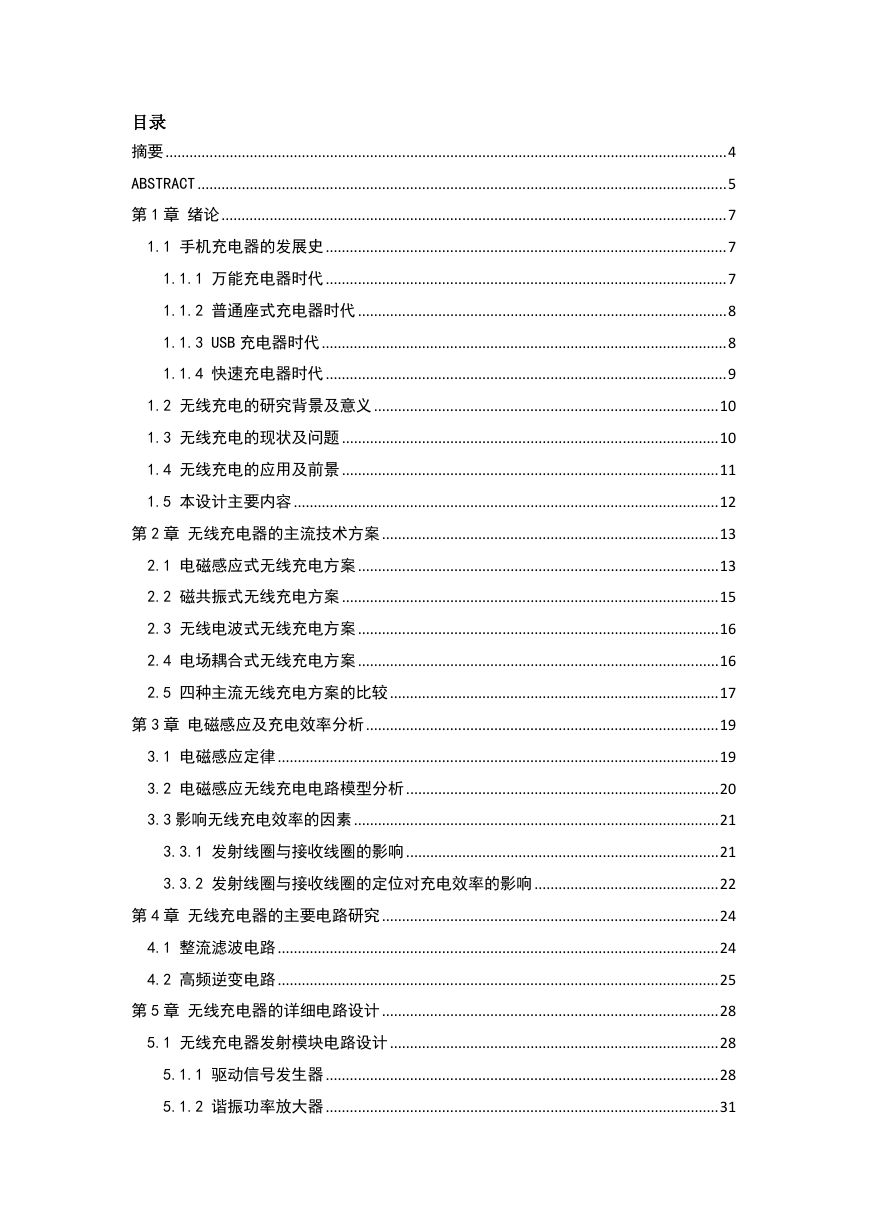
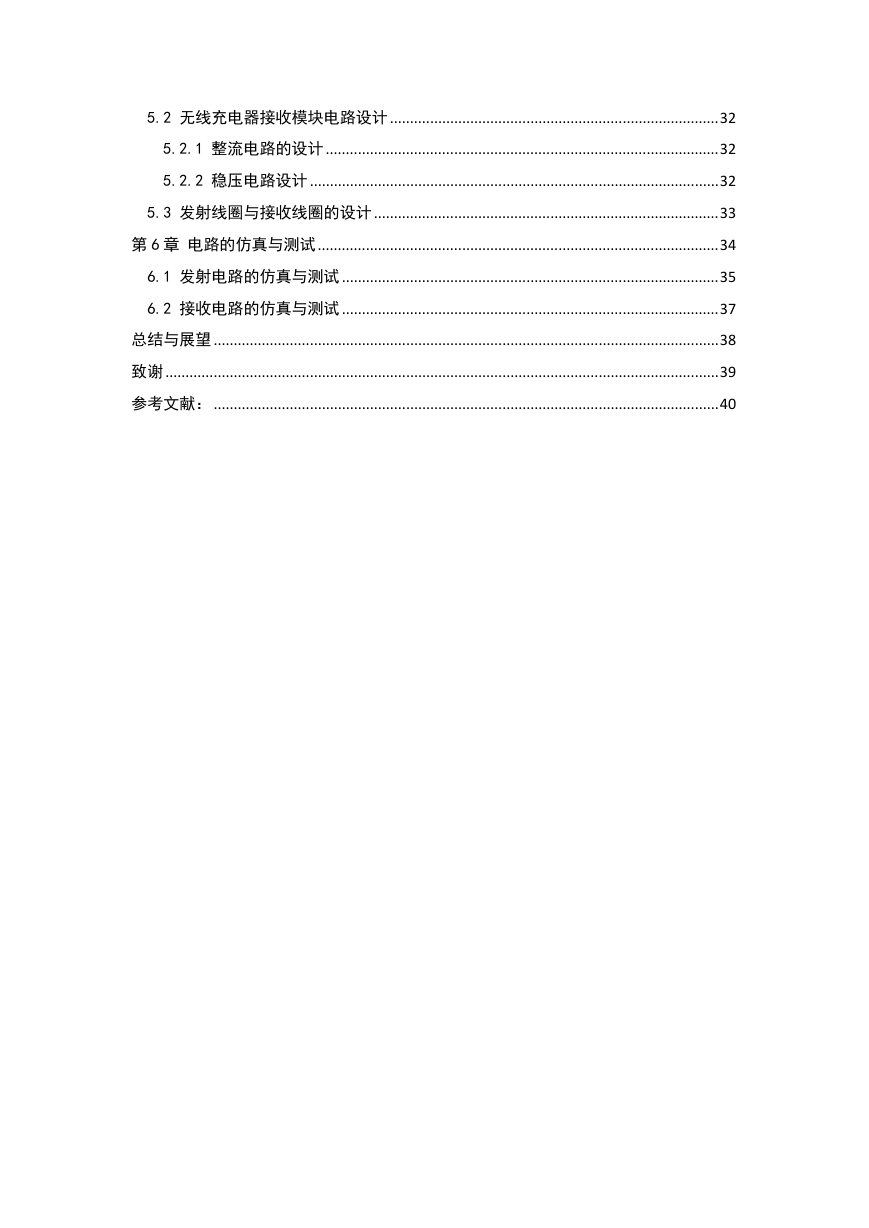

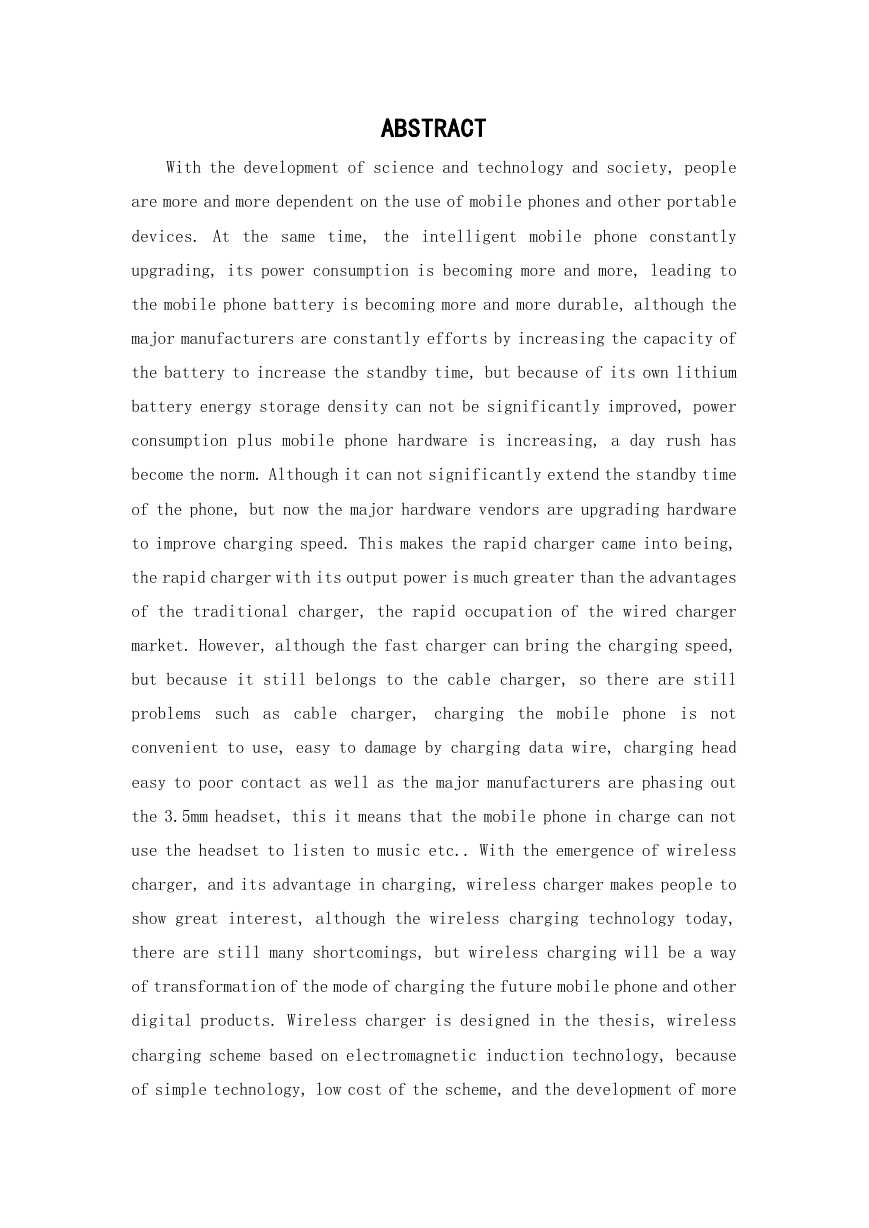
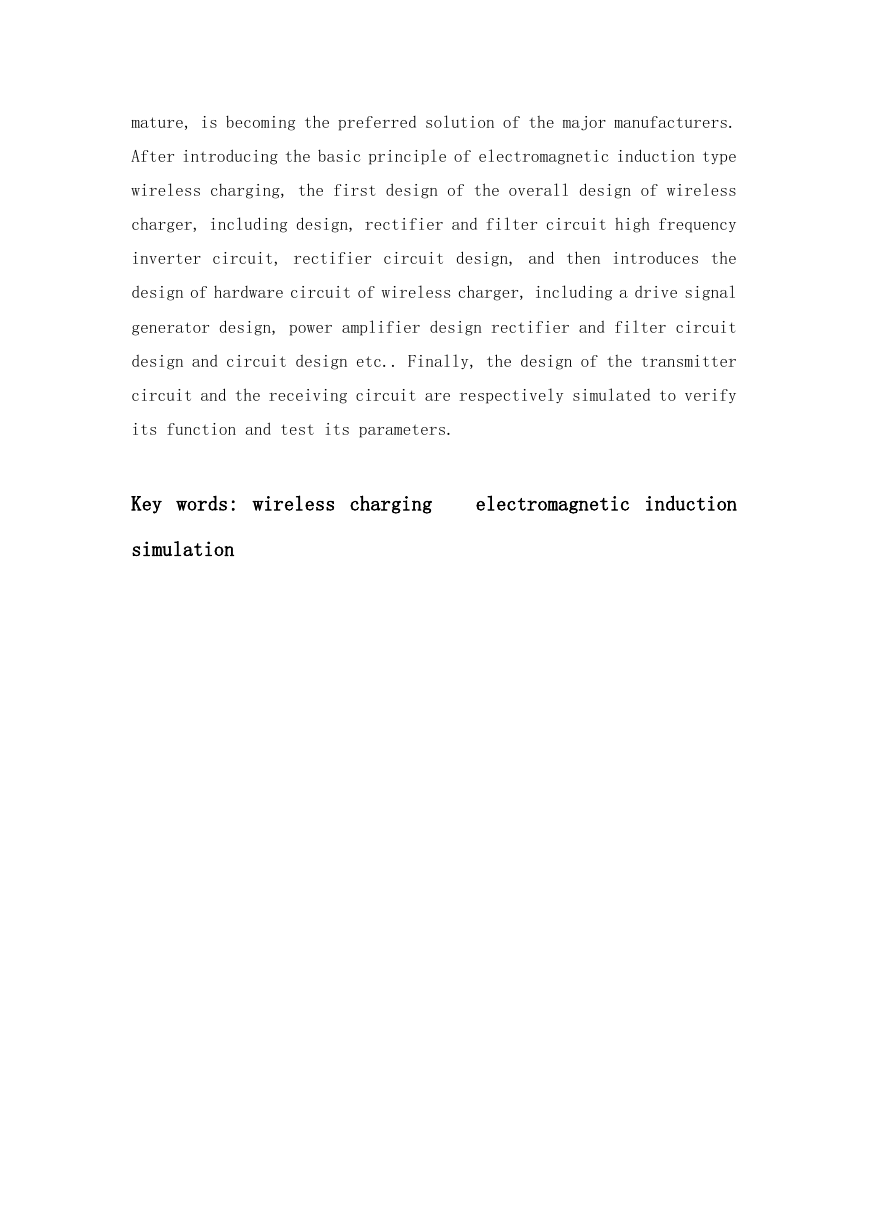
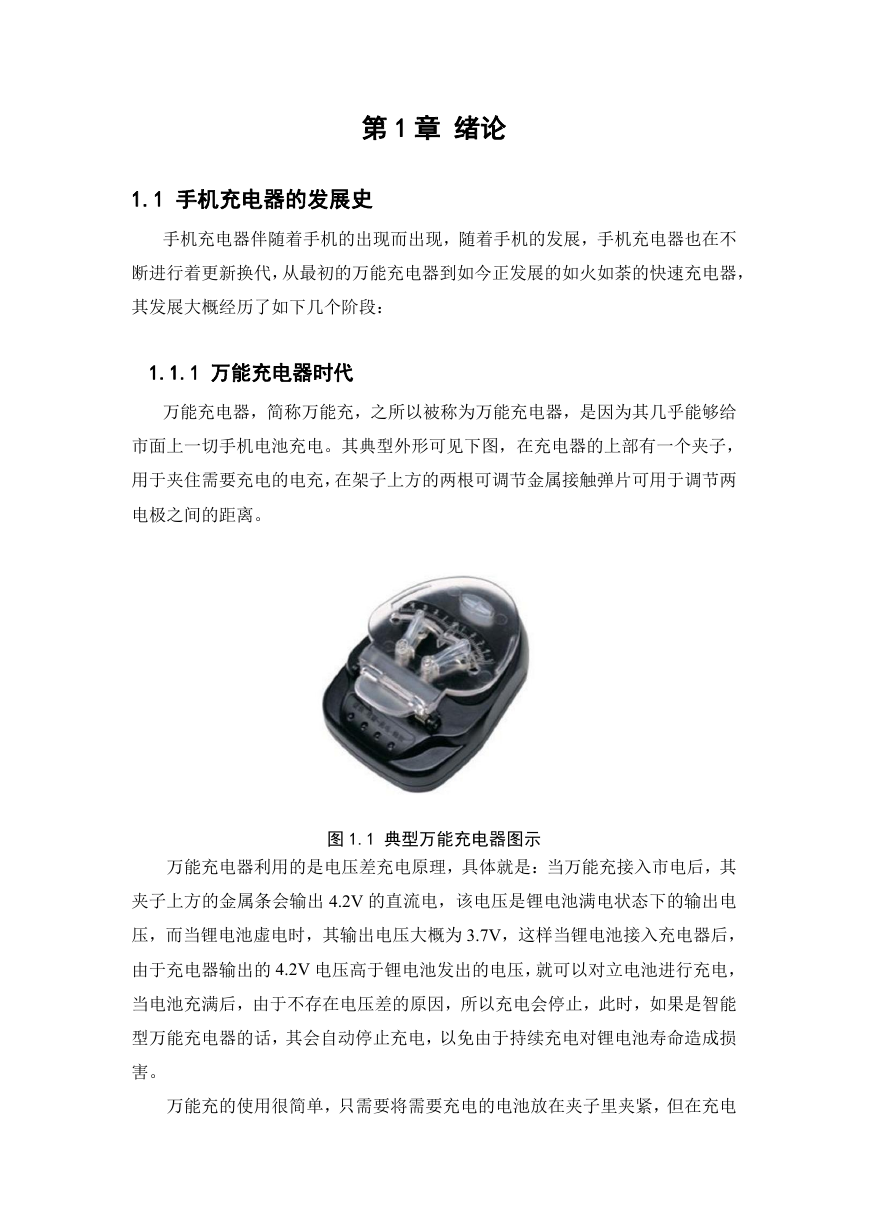
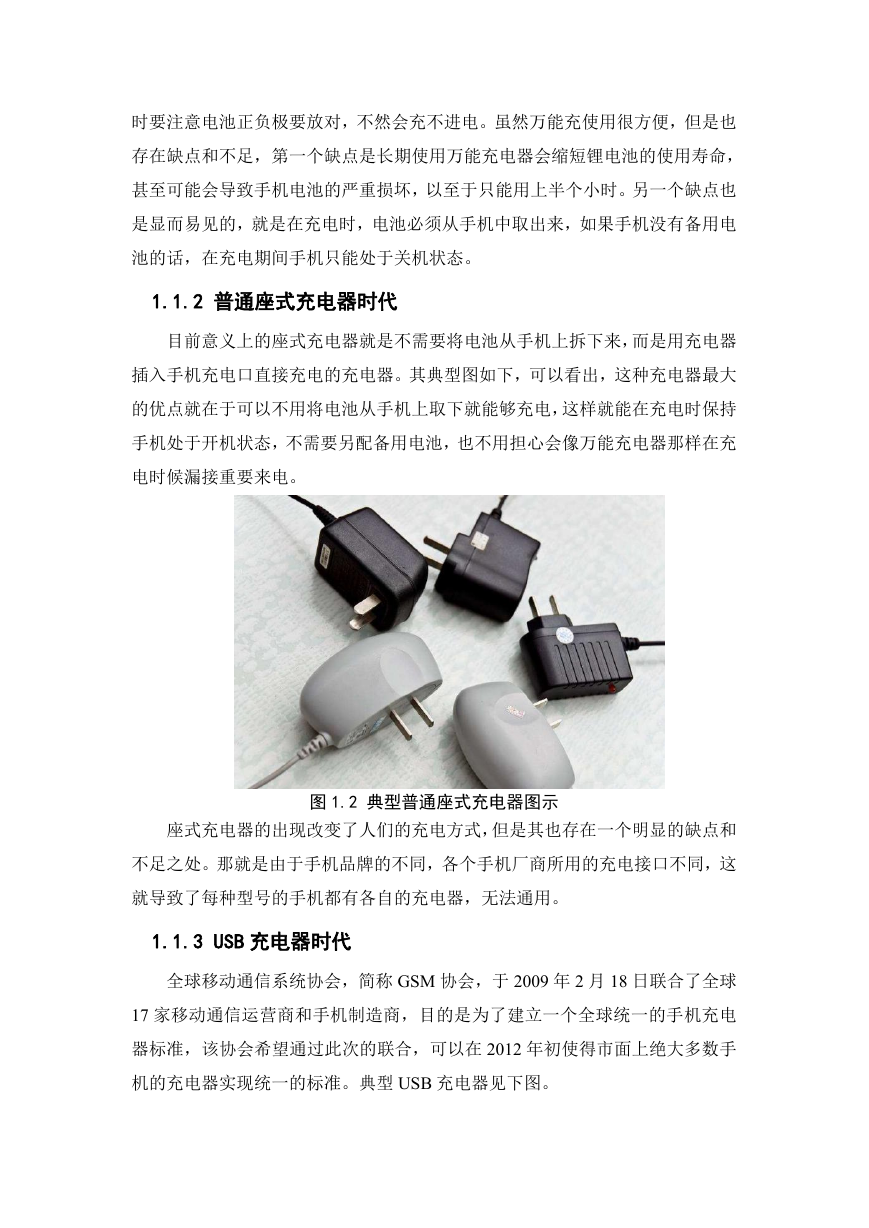








 2023年江西萍乡中考道德与法治真题及答案.doc
2023年江西萍乡中考道德与法治真题及答案.doc 2012年重庆南川中考生物真题及答案.doc
2012年重庆南川中考生物真题及答案.doc 2013年江西师范大学地理学综合及文艺理论基础考研真题.doc
2013年江西师范大学地理学综合及文艺理论基础考研真题.doc 2020年四川甘孜小升初语文真题及答案I卷.doc
2020年四川甘孜小升初语文真题及答案I卷.doc 2020年注册岩土工程师专业基础考试真题及答案.doc
2020年注册岩土工程师专业基础考试真题及答案.doc 2023-2024学年福建省厦门市九年级上学期数学月考试题及答案.doc
2023-2024学年福建省厦门市九年级上学期数学月考试题及答案.doc 2021-2022学年辽宁省沈阳市大东区九年级上学期语文期末试题及答案.doc
2021-2022学年辽宁省沈阳市大东区九年级上学期语文期末试题及答案.doc 2022-2023学年北京东城区初三第一学期物理期末试卷及答案.doc
2022-2023学年北京东城区初三第一学期物理期末试卷及答案.doc 2018上半年江西教师资格初中地理学科知识与教学能力真题及答案.doc
2018上半年江西教师资格初中地理学科知识与教学能力真题及答案.doc 2012年河北国家公务员申论考试真题及答案-省级.doc
2012年河北国家公务员申论考试真题及答案-省级.doc 2020-2021学年江苏省扬州市江都区邵樊片九年级上学期数学第一次质量检测试题及答案.doc
2020-2021学年江苏省扬州市江都区邵樊片九年级上学期数学第一次质量检测试题及答案.doc 2022下半年黑龙江教师资格证中学综合素质真题及答案.doc
2022下半年黑龙江教师资格证中学综合素质真题及答案.doc